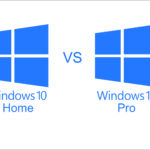
Difference Between Windows 10 Pro and Windows 10 Home
Microsoft offers Windows 10 in two versions: Home and Professional. It’s easy to understand on a conceptual level what this means. Pro is for people to use at work, and Home is for personal machines. But what’s the real difference? Let’s take a look at Windows 10 Home vs. Windows 10 Pro.
Overall Findings
Windows 10 Home
Windows Store for home use.
Can join a workgroup.
Windows 10 Pro
Windows Store for Business.
Additional security features.
Administrative and enterprise tools.
Can join an Azure Active Directory Domain.
Knowing your needs for an operating system helps in your decision between Windows 10 Home versus Windows 10 Pro. If you’re a home user, Windows 10 Home will take care of your computing needs. If you need complex features, such as a network domain or the ability to manage group policies on several computers (such as a small office), Windows 10 Pro has these advanced features to make management easy and centralized.
If your networking needs are less complicated or you have a single computer, Windows 10 Home should be sufficient for an operating system. If you’re on a budget, the lower price should help. If you find out later that you need more advanced features, Microsoft charges $99 to upgrade rather than buying a new license.
Features: Windows 10 Pro Has More Features
Windows 10 Home
Remote desktop support requires a third-party app.
Requires a third-party app for a virtual desktop.
Windows Store for home use.
Updates occur through Windows Update.
Windows 10 Pro
Remote desktop.
Client Hyper-V.
Group policy management.
Enterprise state roaming with Azure Active Directory.
Assigned Access.
Dynamic Provisioning.
Windows Update for Business.
Shared PC configuration.
Security: Windows 10 Pro Has Additional Security Features
Windows 10 Home
Requires a third-party app purchase for encryption.
Windows Defender Antivirus.
Windows Hello.
Windows 10 Pro
Built-in encryption (BitLocker) and management.
Windows Defender Antivirus.
Windows Hello.
Windows Information Protection.
In addition to the user account management features, Windows 10 Pro includes Bitlocker, a Microsoft encryption utility. It can secure either the disk with the OS (for example, the C: drive) or removable media like thumb drives.
While there are other disk encryption tools available, Bitlocker integrates with your company’s infrastructure, meaning your admin can secure your machine without you having to worry about it.
Fundamentals Features: Windows 10 Home Doesn’t Have Windows Fundamentals
Windows 10 Home
Requires a third-party app for a virtual desktop.
Remote desktop support requires a third-party app.
Windows 10 Pro
Domain Join.
Azure Active Directory Domain Join.
Remote Desktop with central management.
Client Hyper-V.
Windows Fundamentals includes some features that have been present in Windows for some time, going back to when it was originally separated into Pro and Home versions.
The below examples of these have been bumped up to become Pro version upgrades or features that Home users can’t use until they upgrade to Pro.
Domain Join: The Windows Domain is one of the basic building blocks of business networks, and controls access to network resources such as file drives and printers.
Azure Active Directory Domain Join, with Single Sign-On to Cloud-Hosted Apps: Remembering your credentials to access enterprise apps can be burdensome for you, and maintaining those accounts is difficult for administrators. Single sign-on is a way to maintain one username and password and use it to authenticate everywhere you need. Microsoft offers its Active Directory service (running from its Azure cloud) to allow organizations using Windows 10 Pro to take advantage of this.
Remote Desktop: Remote control of your home computer is an example of a feature that almost any user would love to have. However, the built-in Windows Remote Desktop functionality is limited to Windows Pro users.
Client Hyper-V: Users must have Windows Pro to use Microsoft’s virtual machine solution, Hyper-V. While this is a built-in function, you can replicate it with other programs. For example, use Oracle VirtualBox to run Ubuntu on Windows.
Management Features: Windows 10 Pro Has Management and Deployment Features
Windows 10 Home
Windows updates occur through Windows Update.
Windows 10 Pro
Group policy management.
Enterprise state roaming with Azure Active Directory.
Windows Store for Business.
Assigned Access.
Dynamic Provisioning.
Shared PC configuration.
Windows Update for Business.
Some Windows 10 Pro advantages won’t be as important to the personal computing enthusiast. Nonetheless, it’s worth knowing some of the business-focused functions you’d pay for if you upgraded to Pro:
Group Policy: Group Policy allows administrators to limit what users can do using a centralized set of roles. This includes security elements such as password complexity and whether users can access network resources or install applications.
Enterprise State Roaming with Azure Active Directory: This allows users to synchronize important settings and application info across devices through the Microsoft Azure cloud. This doesn’t include documents and files, but rather how the machine is configured.
Windows Store for Business: This is like the consumer-facing Windows Store, except this one allows business users to purchase apps at volume. They can also manage those purchases or subscriptions for all users in the organization.
Assigned Access: Assigned Access allows administrators to create a kiosk out of a PC, meaning users can only access a single app, typically a web browser.
Dynamic Provisioning: In the past, getting a new PC ready to use within an organization was a big undertaking. Administrators needed to enable and disable features set up the user and device on the corporate domain, and install applications. Dynamic Provisioning allows the admin to create a profile on a USB drive. When starting a new machine, the admin inserts the drive, and the PC auto-configures with whatever the admin desires.
Windows Update for Business: This is also an enterprise-focused counterpart to Windows Update. It allows admins to control the updates, such as when and how PCs update.
Shared PC Configuration: A mode suited to setting up more than one individual on a PC, such as for temporary workers.
Take a Test: Like the above-mentioned Shared PC and Assigned Access setups, Take a Test is focused on the educational market and allows users to sign in to take an exam.
Final Verdict: Choose the Version for Your Needs
You’ll need to choose between Home and Pro when you buy a computer, or when you buy a copy of Windows in a store or online. Take a moment to give it some thought before you make your purchase, for two reasons:
Upgrading from Home to Pro: On the other hand, upgrading from Home to Pro is straightforward. When you upgrade, the Pro license supersedes the Home license.
If you buy Windows 10 Pro, but later realize you only need Windows 10 Home, buy a license for Home and activate it on the machine with Pro. This will leave you with an unused Pro license.
If you plan to use the machine for business purposes at some point, or if you’re not concerned about cost, go with Windows 10 Pro. However, if you don’t believe you need the enterprise features of Pro, your best bet is to get Windows 10 Home.
You can get Original License Keys from Techlover Enterprises at a lower rate
Originally posted 2024-01-30 13:18:51.



















